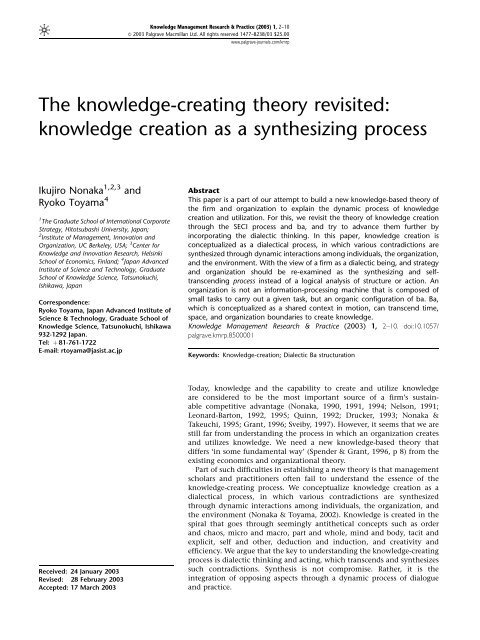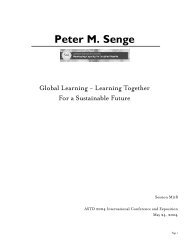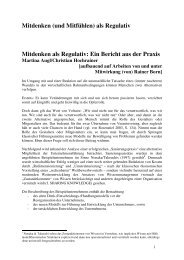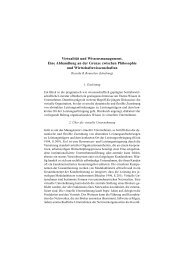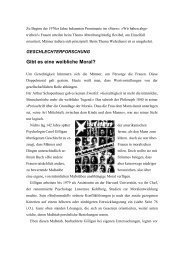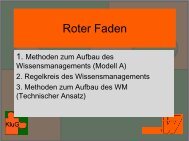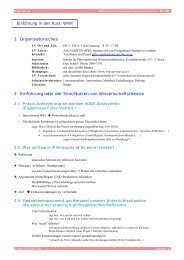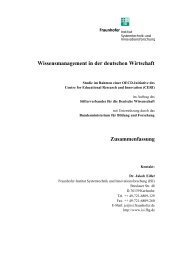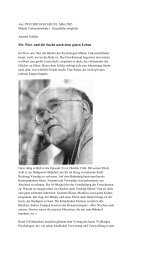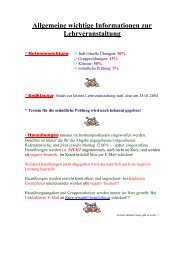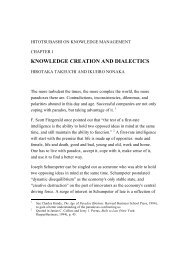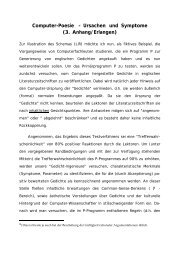The knowledge-creating theory revisited: knowledge creation as a ...
The knowledge-creating theory revisited: knowledge creation as a ...
The knowledge-creating theory revisited: knowledge creation as a ...
You also want an ePaper? Increase the reach of your titles
YUMPU automatically turns print PDFs into web optimized ePapers that Google loves.
Knowledge Management Research & Practice (2003) 1, 2–10<br />
& 2003 Palgrave Macmillan Ltd. All rights reserved 1477–8238/03 $25.00<br />
www.palgrave-journals.com/kmrp<br />
<strong>The</strong> <strong>knowledge</strong>-<strong>creating</strong> <strong>theory</strong> <strong>revisited</strong>:<br />
<strong>knowledge</strong> <strong>creation</strong> <strong>as</strong> a synthesizing process<br />
Ikujiro Nonaka 1,2,3 and<br />
Ryoko Toyama 4<br />
1 <strong>The</strong> Graduate School of International Corporate<br />
Strategy, Hitotsub<strong>as</strong>hi University, Japan;<br />
2 Institute of Management, Innovation and<br />
Organization, UC Berkeley, USA; 3 Center for<br />
Knowledge and Innovation Research, Helsinki<br />
School of Economics, Finland; 4 Japan Advanced<br />
Institute of Science and Technology, Graduate<br />
School of Knowledge Science, Tatsunokuchi,<br />
Ishikawa, Japan<br />
Correspondence:<br />
Ryoko Toyama, Japan Advanced Institute of<br />
Science & Technology, Graduate School of<br />
Knowledge Science, Tatsunokuchi, Ishikawa<br />
932-1292 Japan.<br />
Tel: þ 81-761-1722<br />
E-mail: rtoyama@j<strong>as</strong>ist.ac.jp<br />
Abstract<br />
This paper is a part of our attempt to build a new <strong>knowledge</strong>-b<strong>as</strong>ed <strong>theory</strong> of<br />
the firm and organization to explain the dynamic process of <strong>knowledge</strong><br />
<strong>creation</strong> and utilization. For this, we revisit the <strong>theory</strong> of <strong>knowledge</strong> <strong>creation</strong><br />
through the SECI process and ba, and try to advance them further by<br />
incorporating the dialectic thinking. In this paper, <strong>knowledge</strong> <strong>creation</strong> is<br />
conceptualized <strong>as</strong> a dialectical process, in which various contradictions are<br />
synthesized through dynamic interactions among individuals, the organization,<br />
and the environment. With the view of a firm <strong>as</strong> a dialectic being, and strategy<br />
and organization should be re-examined <strong>as</strong> the synthesizing and selftranscending<br />
process instead of a logical analysis of structure or action. An<br />
organization is not an information-processing machine that is composed of<br />
small t<strong>as</strong>ks to carry out a given t<strong>as</strong>k, but an organic configuration of ba. Ba,<br />
which is conceptualized <strong>as</strong> a shared context in motion, can transcend time,<br />
space, and organization boundaries to create <strong>knowledge</strong>.<br />
Knowledge Management Research & Practice (2003) 1, 2–10. doi:10.1057/<br />
palgrave.kmrp.8500001<br />
Keywords: Knowledge-<strong>creation</strong>; Dialectic Ba structuration<br />
Received: 24 January 2003<br />
Revised: 28 February 2003<br />
Accepted: 17 March 2003<br />
Today, <strong>knowledge</strong> and the capability to create and utilize <strong>knowledge</strong><br />
are considered to be the most important source of a firm’s sustainable<br />
competitive advantage (Nonaka, 1990, 1991, 1994; Nelson, 1991;<br />
Leonard-Barton, 1992, 1995; Quinn, 1992; Drucker, 1993; Nonaka &<br />
Takeuchi, 1995; Grant, 1996; Sveiby, 1997). However, it seems that we are<br />
still far from understanding the process in which an organization creates<br />
and utilizes <strong>knowledge</strong>. We need a new <strong>knowledge</strong>-b<strong>as</strong>ed <strong>theory</strong> that<br />
differs ‘in some fundamental way’ (Spender & Grant, 1996, p 8) from the<br />
existing economics and organizational <strong>theory</strong>.<br />
Part of such difficulties in establishing a new <strong>theory</strong> is that management<br />
scholars and practitioners often fail to understand the essence of the<br />
<strong>knowledge</strong>-<strong>creating</strong> process. We conceptualize <strong>knowledge</strong> <strong>creation</strong> <strong>as</strong> a<br />
dialectical process, in which various contradictions are synthesized<br />
through dynamic interactions among individuals, the organization, and<br />
the environment (Nonaka & Toyama, 2002). Knowledge is created in the<br />
spiral that goes through seemingly antithetical concepts such <strong>as</strong> order<br />
and chaos, micro and macro, part and whole, mind and body, tacit and<br />
explicit, self and other, deduction and induction, and creativity and<br />
efficiency. We argue that the key to understanding the <strong>knowledge</strong>-<strong>creating</strong><br />
process is dialectic thinking and acting, which transcends and synthesizes<br />
such contradictions. Synthesis is not compromise. Rather, it is the<br />
integration of opposing <strong>as</strong>pects through a dynamic process of dialogue<br />
and practice.
Knowledge-<strong>creating</strong> <strong>theory</strong> <strong>revisited</strong> Ikujiro Nonaka and Ryoko Toyama 3<br />
We also need to understand that <strong>knowledge</strong> <strong>creation</strong> is<br />
a transcending process through which entities (individuals,<br />
groups, organizations, etc) transcend the boundary<br />
of the old into a new self by acquiring new <strong>knowledge</strong>. In<br />
the process, new conceptual artifacts and structures for<br />
interaction are created, which provide possibilities <strong>as</strong> well<br />
<strong>as</strong> constrain the entities in consequent <strong>knowledge</strong><strong>creation</strong><br />
cycles. Thus, the entities coexist with the<br />
environment because they are subject to environmental<br />
influence <strong>as</strong> much <strong>as</strong> the environment is influenced by<br />
the entities. This conceptualization of the interdependent<br />
connection between the entities and structure is<br />
similar to the Structuration <strong>theory</strong> (Giddens, 1984). <strong>The</strong><br />
existing theories that deal with a static status of an<br />
organization at one point of time cannot deal with such a<br />
dynamic process.<br />
This paper is a part of our attempt to build a new<br />
<strong>knowledge</strong>-b<strong>as</strong>ed <strong>theory</strong> of the firm and organization to<br />
explain the dynamic process of <strong>knowledge</strong> <strong>creation</strong> and<br />
utilization. For this, we revisit the <strong>theory</strong> of <strong>knowledge</strong><br />
<strong>creation</strong> through the SECI process (Nonaka, 1991;<br />
Nonaka & Takeuchi, 1995) and Ba (Nonaka et al., 2000a),<br />
and try to advance them further by incorporating the<br />
dialectic thinking such <strong>as</strong> Hegel, and Bh<strong>as</strong>kar (1993),<br />
E<strong>as</strong>tern philosophy, and the Structuration <strong>theory</strong> (Giddens,<br />
1984). We ac<strong>knowledge</strong> the ontological differences<br />
between Structuration <strong>theory</strong> and critical realism and<br />
utilize the Giddensian view mainly to explain the interrelation<br />
between the agents and the context, and critical<br />
realism <strong>as</strong> a methodology to explain the interaction<br />
between tacit and explicit <strong>knowledge</strong> or between the<br />
invisible and visible. <strong>The</strong> b<strong>as</strong>ic argument is that <strong>knowledge</strong><br />
<strong>creation</strong> is a synthesizing process through which an<br />
organization interacts with individuals and the environment<br />
to transcend emerging contradictions that the<br />
organization faces. This interconnection between agents<br />
and the structure makes the <strong>knowledge</strong> process to occur<br />
<strong>as</strong> a dynamic and inter-linked interaction from an<br />
individual-to-societal level.<br />
Organization <strong>as</strong> information-processing machine<br />
vs <strong>knowledge</strong>-<strong>creating</strong> entity<br />
<strong>The</strong> traditional organization <strong>theory</strong> is b<strong>as</strong>ed on the view<br />
of an organization <strong>as</strong> an information-processing machine<br />
that takes and processes information from the environment<br />
to solve a problem and adapts to the environment<br />
b<strong>as</strong>ed on a given goal. Because of the bounded rationality<br />
of human beings, an organization is necessary to deal<br />
with a complex reality. Reality is cut into pieces of<br />
information that are small and simple enough for one<br />
person to process. <strong>The</strong>n the information is processed and<br />
re<strong>as</strong>sembled by the organizational members so that<br />
the organization <strong>as</strong> a whole deals with the complex<br />
reality in the end. This can be e<strong>as</strong>ily understood with the<br />
example of car manufacturing. A car manufacturing<br />
process is broken down into various simple t<strong>as</strong>ks, and<br />
each worker is <strong>as</strong>signed one t<strong>as</strong>k so that even an unskilled<br />
worker can e<strong>as</strong>ily accomplish it. A worker does not need<br />
to understand what others are doing, and what his/her<br />
t<strong>as</strong>k means to the entire car manufacturing processes. <strong>The</strong><br />
issue for the organization, therefore, is how the entire<br />
process can be divided into small t<strong>as</strong>ks or modules and<br />
how they can be coordinated so that a car can be built in<br />
the end.<br />
This is a static and p<strong>as</strong>sive view of the organization and<br />
it fails to capture the dynamic process through which the<br />
organization interacts with the organizational members<br />
and the environment. Instead of merely solving problems,<br />
organizations create and define problems, develop<br />
and apply <strong>knowledge</strong> to solve the problems, and then<br />
further develop new <strong>knowledge</strong> through the action of<br />
problem solving. <strong>The</strong> organization and individuals grow<br />
through such process. <strong>The</strong> organization is not merely an<br />
information-processing machine, but an entity that<br />
creates <strong>knowledge</strong> through action and interaction (Nonaka<br />
et al., 2000b). In the process, the binding interdependence<br />
between the agents and environment offers<br />
possibilities and also initiates limits, which determine<br />
the boundaries for the <strong>knowledge</strong> <strong>creation</strong>. Further, in<br />
addition to structural interaction, dialectic <strong>knowledge</strong><br />
<strong>creation</strong> occurs <strong>as</strong> the actors embrace their environment<br />
and synthesize tacit and explicit <strong>knowledge</strong> in social<br />
space.<br />
Knowledge is not just a part of the reality. It is a reality<br />
viewed from a certain angle. <strong>The</strong> same reality can be<br />
viewed differently depending on from which angle (context)<br />
one sees it. In <strong>knowledge</strong> <strong>creation</strong>, one cannot be free<br />
from one’s own context. Social, cultural, and historical<br />
contexts are important for individuals (Vygotsky, 1986)<br />
because such contexts give the b<strong>as</strong>is for one to interpret<br />
information to create meanings. That is why limited<br />
environmental interaction and externalization of personal<br />
<strong>knowledge</strong> can lead to ontological ills and fallacies,<br />
because the whole complexity of given phenomenon<br />
may remain undiscovered. Hence, in <strong>knowledge</strong> <strong>creation</strong>,<br />
one tries to see the entire picture of reality by interacting<br />
with those who see the reality from other angles, that is,<br />
sharing their contexts. In the c<strong>as</strong>e of car manufacturing,<br />
the continuous process innovation that typically occurs<br />
at Toyota requires workers to view and understand their<br />
t<strong>as</strong>k <strong>as</strong> a part of the entire car manufacturing process, and<br />
share their <strong>knowledge</strong> about their t<strong>as</strong>k to make improvements<br />
on the process. It is important here to understand<br />
how the interactions among the parts (individuals, work<br />
groups, etc.) are dynamically linked to form a continuously<br />
evolving whole, which, in turn, impacts the environment<br />
where the car manufacturing takes place.<br />
Since individuals have different goals and contexts,<br />
contradictions are inevitable among individuals and the<br />
organization to which they belong. Traditional organization<br />
theories try to solve such contradictions through the<br />
design of organizational structure, incentive systems,<br />
routines, or organizational culture. However, if we view<br />
an organization <strong>as</strong> a <strong>knowledge</strong>-<strong>creating</strong> entity, we can<br />
see such contradictions <strong>as</strong> necessities to create <strong>knowledge</strong><br />
instead of obstacles to overcome. Knowledge is created<br />
Knowledge Management Research & Practice
4<br />
Knowledge-<strong>creating</strong> <strong>theory</strong> <strong>revisited</strong><br />
Ikujiro Nonaka and Ryoko Toyama<br />
through the synthesis of contradictions, instead of<br />
finding an optimal balance between contradictions.<br />
Knowledge <strong>creation</strong> and the role of strategy<br />
With this view of organization <strong>as</strong> an entity that creates<br />
<strong>knowledge</strong> continuously, we also need to re-examine the<br />
role of strategy, which is to solve the contradictions<br />
between the organization and the environment. Typically<br />
represented by the SWOT framework by Andrews<br />
(1971), the role of strategy is to adapt the organization to<br />
the threats and opportunities in the environment with<br />
the given strengths and weaknesses of the organization.<br />
Such a framework is later refined into two mainstream<br />
researches of strategy–the positioning school and the<br />
resource-b<strong>as</strong>ed view. <strong>The</strong> positioning school mainly<br />
focuses on the environment in which the organization<br />
operates (Porter, 1980). An organization needs to choose<br />
the environment in which it can build and sustain<br />
competitive advantages. <strong>The</strong> environment can be viewed<br />
<strong>as</strong> a moving target to which the companies are desperately<br />
trying to modify their operations. Hence, the<br />
positioning school tends to stress the analysis of the<br />
environment and ignore the internal process of the<br />
organization.<br />
<strong>The</strong> resource-b<strong>as</strong>ed view of a firm, on the other hand,<br />
does look inside of firms, in terms of the resources it<br />
owns. According to this view, a firm is a collection of<br />
resources, and those with superior resources will earn<br />
rents (Penrose, 1959; Teece, 1980, 1982; Wernerfelt, 1984;<br />
Conner, 1991; Mahoney and Pandian, 1992). However,<br />
empirical and theoretical research on the resource-b<strong>as</strong>ed<br />
view of the firm so far h<strong>as</strong> been mainly focused on how<br />
firms keep their unique resources and resulting competitive<br />
advantages through such conditions <strong>as</strong> imperfect<br />
imitability, imperfect substitutability, and limited mobility<br />
of resources (Wernerfelt, 1984; Barney, 1986, 1991;<br />
Dierickx & Cool, 1989; Amit & Schoemaker, 1993;<br />
Peteraf, 1993). Although it deals with the dynamic<br />
capability of the firm (Teece et al., 1990), the resourceb<strong>as</strong>ed<br />
view of the firm fails to explain the dynamism in<br />
which the firm continuously builds such resources<br />
through the interactions with the environment. <strong>The</strong>re<br />
is very little theoretical understanding on how a firm<br />
accumulates such resources (Levinthal & Myatt, 1994),<br />
except for the recent conceptualization of dynamic<br />
capabilities <strong>as</strong> a set of specific and identifiable processes<br />
such <strong>as</strong> product development, strategic decision-making,<br />
and alliancing (Eisenhardt & Martin, 2000).<br />
We argue that <strong>knowledge</strong> is created through the<br />
synthesis of the contradictions between the organization’s<br />
internal resources and the environment. Thus,<br />
strategy in a dialectic company can be conceptualized <strong>as</strong><br />
a combination of internal resources <strong>as</strong> well <strong>as</strong> environmental<br />
adjustment. Hence, we need a new <strong>theory</strong> that<br />
focuses on such interactions. <strong>The</strong> following section<br />
explains how <strong>knowledge</strong> is created through the interaction<br />
between tacit and explicit <strong>knowledge</strong>, and the<br />
organization and the environment.<br />
Knowledge <strong>creation</strong> <strong>as</strong> a synthesizing process<br />
How can we synthesize the environment and internal<br />
resources? To answer that question, we visit the Structuration<br />
<strong>theory</strong> by Giddens (1984). Structuration means<br />
studying the ways in which social systems are produced<br />
and reproduced in social interaction. Structuration<br />
<strong>theory</strong> views humans <strong>as</strong> role-taking and norm-fulfilling<br />
beings who act according to their images of what reality<br />
is, and treats all institutions and social practices <strong>as</strong><br />
structures. On the one hand, the environment influences<br />
agents, and on the other hand, the agents are continuously<br />
re<strong>creating</strong> their environment through social<br />
interaction. Hence, social structure does not exist<br />
independently outside of human agency. Rather, structure<br />
and humans are two ways of considering social<br />
action and they interplay in defining and reproducing<br />
each other.<br />
Knowledge is created through such interactions between<br />
human agency and social structures. Our actions<br />
and interactions with the environment create and<br />
enlarge <strong>knowledge</strong> through the conversion process of<br />
tacit and explicit <strong>knowledge</strong> <strong>as</strong> shown in Figure 1<br />
(Nonaka, 1990, 1991, 1994; Nonaka & Takeuchi, 1995).<br />
Giddens argues that we enact our actions with two main<br />
levels of consciousness: practical consciousness and<br />
discursive consciousness in our daily lives. While the<br />
discursive consciousness gives us our rationalizations for<br />
actions and refers to more conscious and therefore more<br />
explicitly theoretical knowing, practical consciousness<br />
refers to the level of our lives that we do not really think<br />
about or theorize. In that sense, we can say that tacit<br />
<strong>knowledge</strong> is produced by our practical consciousness<br />
and explicit <strong>knowledge</strong> is produced by our discursive<br />
consciousness.<br />
Where<strong>as</strong> these two levels of consciousness act harmoniously<br />
in the Structuration <strong>theory</strong>, we claim that tacit<br />
and explicit <strong>knowledge</strong> act dialectically because of the<br />
inherent contr<strong>as</strong>t between the routine and <strong>theory</strong> or tacit<br />
and explicit <strong>knowledge</strong>. Critical realism explains these<br />
differences between the domains of real and the domains<br />
of actual and empirical (Bh<strong>as</strong>kar, 1978). Where<strong>as</strong> the<br />
domain of real is the domain in which generative<br />
mechanisms reside, the domains of actual and empirical<br />
contain observed and experienced events. Owing to the<br />
inability to move to the domain of real, science is often<br />
spatio-temporally restricted and subject to ontological<br />
fallacies.<br />
Knowledge <strong>creation</strong> starts with Socialization, which is<br />
the process of converting new tacit <strong>knowledge</strong> through<br />
shared experiences in day-to-day social interaction. Since<br />
tacit <strong>knowledge</strong> is difficult to formalize and often timeand<br />
space-specific, tacit <strong>knowledge</strong> can be acquired only<br />
through shared direct experience, such <strong>as</strong> spending time<br />
together or living in the same environment, typically a<br />
traditional apprenticeship where apprentices learn the<br />
tacit <strong>knowledge</strong> needed in their craft through hands-on<br />
experiences. One can share the tacit <strong>knowledge</strong> of customers,<br />
suppliers, and even competitors by empathizing<br />
Knowledge Management Research & Practice
Knowledge-<strong>creating</strong> <strong>theory</strong> <strong>revisited</strong> Ikujiro Nonaka and Ryoko Toyama 5<br />
Figure 1<br />
SECI model of <strong>knowledge</strong> <strong>creation</strong>.<br />
with them through shared experience. Thus, routines are<br />
part of tacit <strong>knowledge</strong> because they are developed in<br />
close interaction over time.<br />
In the socialization process, the phenomenological<br />
method of seeing things <strong>as</strong> they are is effective. By<br />
‘indwelling’ or ‘living in’ the world, individuals accumulate<br />
and share tacit <strong>knowledge</strong> about the world that<br />
surrounds them. For example, one can accumulate the<br />
tacit <strong>knowledge</strong> about customers through his/her own<br />
experience <strong>as</strong> a customer. Here, individuals embrace<br />
contradictions rather than confront them. This enables<br />
actors to absorb <strong>knowledge</strong> in their social environment<br />
through action and perception. Hence, the dichotomy<br />
between the environment and the organization can be<br />
synthesized in the socialization process <strong>as</strong> members of<br />
the organization accumulate and share the tacit <strong>knowledge</strong><br />
of the environment through their practical consciousness.<br />
Such tacit <strong>knowledge</strong> is articulated into explicit <strong>knowledge</strong><br />
through the process of Externalization. Tacit <strong>knowledge</strong><br />
is made explicit so that it can be shared by others to<br />
become the b<strong>as</strong>is of new <strong>knowledge</strong> such <strong>as</strong> concepts,<br />
images, and written documents. During the externalization<br />
stage, individuals use their discursive consciousness<br />
and try to rationalize and articulate the world that<br />
surrounds them. Here, dialogue is an effective method<br />
to articulate one’s tacit <strong>knowledge</strong> and share the<br />
articulated <strong>knowledge</strong> with others. Through dialogues<br />
among individuals, contradictions between one’s tacit<br />
<strong>knowledge</strong> and the structure, or contradictions among<br />
tacit <strong>knowledge</strong> of individuals are made explicit and<br />
synthesized. To make a hidden concept or mechanism<br />
explicit out of accumulated tacit <strong>knowledge</strong>, abduction<br />
or retroduction is effective rather than induction or<br />
deduction. <strong>The</strong> sequential use of metaphor, analogy, and<br />
model is a b<strong>as</strong>ic method in abduction (Lawson, 1998). In<br />
addition to the movement from hidden to the surface,<br />
these methods enable actors to create linkages between<br />
the surface and deeper domains of social reality. It is<br />
crucial here to understand that actors seek to detach<br />
themselves from routines by active exposure to a context<br />
that enables them to see the inherent contradiction. This<br />
property is in contr<strong>as</strong>t with the Structuration <strong>theory</strong><br />
where the two levels of consciousness coexist in harmony<br />
and agents find ontological security in routines (cf<br />
Giddens, 1984, p. xxiii).<br />
Explicit <strong>knowledge</strong> is collected from inside or outside<br />
the organization and then combined, edited, or processed<br />
to form more complex and systematic explicit<br />
<strong>knowledge</strong> through the Combination process. <strong>The</strong> new<br />
explicit <strong>knowledge</strong> is then disseminated among the<br />
members of the organization. Creative use of computerized<br />
communication networks and large-scale datab<strong>as</strong>es<br />
can facilitate this mode of <strong>knowledge</strong> conversion. <strong>The</strong><br />
combination mode of <strong>knowledge</strong> conversion can also<br />
include the ‘breakdown’ of concepts. Breaking down a<br />
concept, such <strong>as</strong> a corporate vision, into operationalized<br />
business or product concepts also creates systemic,<br />
explicit <strong>knowledge</strong>. Here, contradictions are solved<br />
through logic rather than synthesized. Rationalism is an<br />
effective method to combine, edit, and break down<br />
explicit <strong>knowledge</strong>.<br />
Explicit <strong>knowledge</strong> created and shared throughout an<br />
organization is then converted into tacit <strong>knowledge</strong> by<br />
individuals through the Internalization process. This stage<br />
can be understood <strong>as</strong> praxis, where <strong>knowledge</strong> is applied<br />
and used in practical situations and becomes the b<strong>as</strong>e for<br />
new routines. Thus, explicit <strong>knowledge</strong>, such <strong>as</strong> product<br />
concepts or manufacturing procedures, h<strong>as</strong> to be actualized<br />
through action, practice, and reflection so that it<br />
can really become <strong>knowledge</strong> of one’s own. For example,<br />
training programs can help trainees to understand an<br />
Knowledge Management Research & Practice
6<br />
Knowledge-<strong>creating</strong> <strong>theory</strong> <strong>revisited</strong><br />
Ikujiro Nonaka and Ryoko Toyama<br />
organization and themselves. By reading documents or<br />
manuals about their jobs and the organization, and by<br />
reflecting upon them, trainees can internalize the explicit<br />
<strong>knowledge</strong> written in such documents to enrich their<br />
tacit <strong>knowledge</strong> b<strong>as</strong>e. Explicit <strong>knowledge</strong> can also be<br />
embodied through simulations or experiments. Pragmatism<br />
of learning-by-doing is an effective method to<br />
test, modify, and embody explicit <strong>knowledge</strong> <strong>as</strong> one’s<br />
own tacit <strong>knowledge</strong>. Internalized <strong>knowledge</strong> affects the<br />
human agency and the structure, <strong>as</strong> it changes the action<br />
of human agency and how it views the structure. <strong>The</strong><br />
synthesis of individuals and the environment occurs at<br />
this level <strong>as</strong> well.<br />
It is important to note that the movement through the<br />
four modes of <strong>knowledge</strong> conversion forms a spiral, not a<br />
circle. In the spiral of <strong>knowledge</strong> <strong>creation</strong>, the interaction<br />
between tacit and explicit <strong>knowledge</strong> is amplified<br />
through the four modes of <strong>knowledge</strong> conversion. <strong>The</strong><br />
spiral becomes larger in scale <strong>as</strong> it moves up the<br />
ontological levels. Knowledge created through the SECI<br />
process can trigger a new spiral of <strong>knowledge</strong> <strong>creation</strong>,<br />
expanding horizontally and vertically <strong>as</strong> it moves<br />
through communities of interaction that transcend<br />
sectional, departmental, divisional, and even organizational<br />
boundaries. Knowledge can be transferred beyond<br />
organizational boundaries, and <strong>knowledge</strong> from different<br />
organizations interacts to create new <strong>knowledge</strong> (Badaracco,<br />
1991; Wikstrom & Normann, 1994; Nonaka &<br />
Takeuchi, 1995; Inkpen, 1996). Through dynamic interaction<br />
among individuals, <strong>knowledge</strong> created by the<br />
organization can trigger the mobilization of <strong>knowledge</strong><br />
held by outside constituents such <strong>as</strong> consumers, affiliated<br />
companies, universities, or distributors. For example, an<br />
innovative new manufacturing process may bring about<br />
changes in the suppliers’ manufacturing process, which<br />
in turn triggers a new round of product and process<br />
innovation at the organization. Another example is the<br />
articulation of tacit <strong>knowledge</strong> possessed by customers<br />
that they themselves have not been able to articulate. A<br />
product works <strong>as</strong> the trigger to elicit tacit <strong>knowledge</strong><br />
when customers give meaning to the product by<br />
purch<strong>as</strong>ing, adapting, using, or not purch<strong>as</strong>ing it. It can<br />
also trigger the changes of customers in terms of their<br />
worldview and eventually reconstruct the environment.<br />
<strong>The</strong>ir actions are then reflected in the innovative process<br />
of the organization and start a new spiral of <strong>knowledge</strong><br />
<strong>creation</strong>. Organizational <strong>knowledge</strong> <strong>creation</strong> is a neverending<br />
process that upgrades itself continuously.<br />
As h<strong>as</strong> been noted, <strong>knowledge</strong> <strong>creation</strong> is a selftranscending<br />
process, in which one reaches out beyond<br />
the boundaries of one’s own existence (Jantsch, 1980). In<br />
socialization, self-transcendence is fundamental because<br />
tacit <strong>knowledge</strong> can only be shared through direct<br />
experiences, which go beyond individuals. For example,<br />
in the socialization process people empathize with their<br />
colleagues and customers, which diminishes barriers<br />
between individuals. B<strong>as</strong>ically, frequent physical interaction<br />
and perception help agents to create shared mental<br />
presentations and routines. In externalization, an individual<br />
transcends the inner and outer boundaries of the self<br />
by committing to the group and becoming one with it.<br />
Here, the sum of the individuals’ intentions and ide<strong>as</strong><br />
fuse and become integrated with the group’s mental<br />
world. This stage is integral because the externalization of<br />
<strong>knowledge</strong> often helps people to see that the same<br />
phenomenon can be viewed in many different and<br />
contr<strong>as</strong>ting ways. In combination, new <strong>knowledge</strong><br />
generated through externalization transcends the group<br />
to be combined. In internalization, individuals reflect<br />
upon themselves by putting themselves in the context of<br />
newly acquired <strong>knowledge</strong> and the environment where<br />
the <strong>knowledge</strong> should be utilized. This again requires selftranscendence.<br />
Ba: <strong>knowledge</strong>-<strong>creating</strong> place<br />
Knowledge needs a physical context to be created. As<br />
stated previously, <strong>knowledge</strong> is context-specific, <strong>as</strong> it<br />
depends on particular time and space (Hayek, 1945).<br />
Knowledge does not just exist in one’s cognition. Rather,<br />
it is created in situated action (Suchman, 1987). In this<br />
paper, the conceptualization of ba is extended to cover<br />
the interdependent interaction between agents and<br />
structures. Thus, ba is a continuously created generative<br />
mechanism that explains the potentialities and tendencies<br />
that either hinder or stimulate <strong>knowledge</strong> creative<br />
activities.<br />
<strong>The</strong>refore, the <strong>knowledge</strong>-<strong>creating</strong> process is necessarily<br />
context-specific in terms of time, space, and relationship<br />
with others. Knowledge cannot be created in<br />
vacuum, and needs a place where information is given<br />
meaning through interpretation to become <strong>knowledge</strong>.<br />
<strong>The</strong> importance of place in human cognition and action<br />
h<strong>as</strong> been discussed by many philosophers. Plato called a<br />
place for a genesis of existence <strong>as</strong> Chora. Aristotles called<br />
a place for a thing to physically exist <strong>as</strong> Topos. Heidegger<br />
called a place for human existence <strong>as</strong> Ort. To include the<br />
concepts of such places but to be specific to <strong>knowledge</strong><br />
<strong>creation</strong>, we introduce the concept of ‘ba’ (which roughly<br />
means ‘place’). Building on the concept that w<strong>as</strong><br />
originally proposed by the Japanese philosopher Kitaro<br />
Nishida (1921, 1970), we define ba <strong>as</strong> a shared context<br />
in motion, in which <strong>knowledge</strong> is shared, created, and<br />
utilized. Ba provides the energy, quality, and places to<br />
perform the individual <strong>knowledge</strong> conversions and to<br />
move along the <strong>knowledge</strong> spiral. In other words, ba<br />
is a phenomenological time and space where <strong>knowledge</strong>,<br />
<strong>as</strong> ‘a stream of meaning’ emerges (Bohm, 1996). New<br />
<strong>knowledge</strong> is created out of existing <strong>knowledge</strong> through<br />
the change of meanings and contexts.<br />
Although it is e<strong>as</strong>ier to consider ba <strong>as</strong> a physical space<br />
such <strong>as</strong> a meeting room, ba should be understood <strong>as</strong> a<br />
multiple interacting mechanism explaining tendencies<br />
for interactions that occur at a specific time and space. Ba<br />
can emerge in individuals, working groups, project<br />
teams, informal circles, temporary meetings, virtual space<br />
such <strong>as</strong> e-mail groups, and at the front-line contact with<br />
Knowledge Management Research & Practice
Knowledge-<strong>creating</strong> <strong>theory</strong> <strong>revisited</strong> Ikujiro Nonaka and Ryoko Toyama 7<br />
Figure 2<br />
Conceptual representation of ba.<br />
the customer. Ba is an existential place where participants<br />
share their contexts and create new meanings through<br />
interactions. Participants of ba bring in their own<br />
contexts, and through interactions with others and the<br />
environment, the contexts of ba, participants, and the<br />
environment change (see Figure 2).<br />
Ba is a way of organizing that is b<strong>as</strong>ed on the meaning it<br />
creates, rather than a form of organization such <strong>as</strong><br />
hierarchy or network. A firm can be viewed <strong>as</strong> an organic<br />
configuration of various ba, where people interact with<br />
each other and the environment b<strong>as</strong>ed on the <strong>knowledge</strong><br />
they have and the meaning they create. When we see a<br />
firm <strong>as</strong> an organic configuration of ba instead of an<br />
organizational structure, we can see what kind of <strong>knowledge</strong><br />
should and can be created, who are the ‘right<br />
people’ with embedded <strong>knowledge</strong>, and what kind of<br />
interactions are needed among them to create <strong>knowledge</strong><br />
without being restricted by the existing organization<br />
structure.<br />
Although the concept of ba seemingly h<strong>as</strong> some<br />
similarities to the concept of ‘communities of practice’<br />
(Lave & Wenger, 1991; Wenger, 1998), there are important<br />
differences. While a community of practice is a place<br />
where the members learn <strong>knowledge</strong> that is embedded in<br />
the community, ba is a place where new <strong>knowledge</strong> is<br />
created. While a community of practice h<strong>as</strong> an identity<br />
and its boundary is firmly set by the t<strong>as</strong>k, culture, and<br />
history of the community, the boundary of ba is fluid and<br />
can be changed quickly, <strong>as</strong> it is set by the participants.<br />
While the membership of a community of practice is<br />
fairly stable, and it takes time for a new participant to<br />
learn about the community to become a full participant,<br />
the membership of ba is not fixed; participants come and<br />
go. Ba is created, functions, and disappears according to<br />
need. Where<strong>as</strong> members of a community of practice<br />
belong to the community, participants of ba relate to the<br />
ba. Ba h<strong>as</strong> a ‘here and now’ quality <strong>as</strong> does an emerging<br />
relationship, and is constantly moving <strong>as</strong> the contexts of<br />
participants and/or the membership of ba change. While<br />
learning occurs in any community of practice, ba needs<br />
energy to become an active ba where <strong>knowledge</strong> is<br />
created.<br />
<strong>The</strong>n, what brings such energy to make an active ba? It<br />
is contradictions and dialectic thinking and acting to<br />
synthesize such contradictions that produces a good ba.<br />
By definition, ba involves various contradictions. Ba<br />
requires multiple contexts, and yet, a shared context is<br />
necessary for a ba to exist. A good ba needs participants of<br />
ba with multi-viewpoints so that they can bring in<br />
various contexts, and a shared context among them h<strong>as</strong><br />
to be fostered. For that, ba needs to be a self-organizing<br />
place with its own intention, direction, or mission.<br />
Ba sets a boundary for interactions among individuals,<br />
and yet the boundary is open. As there are endless<br />
possibilities to one’s own contexts, a certain boundary is<br />
required for a meaningful shared context to emerge. It<br />
should be protected from the contexts outside so that it<br />
can grow its own context. Yet, ba is still an open place<br />
where participants with their own contexts can come and<br />
go, so that ba <strong>as</strong> shared context can continuously evolve.<br />
For a ba to create and maintain energy, the boundary of<br />
ba should be kept permeable, so that it can protect the ba<br />
from outside influence and let necessary contexts in at<br />
the same time.<br />
Ba lets participants share time and space, and yet it<br />
transcends time and space. In <strong>knowledge</strong> <strong>creation</strong>, especially<br />
in socialization and externalization, it is important<br />
for participants to share time and space through direct<br />
experience. A close physical interaction is important in<br />
sharing the context and forming a common language<br />
among participants. However, because ba can exist in a<br />
mental or virtual place <strong>as</strong> well <strong>as</strong> a physical place, it does<br />
not have to be bound to a certain space and time. While<br />
tacit <strong>knowledge</strong> h<strong>as</strong> a ‘here and now’ quality, when it is<br />
Knowledge Management Research & Practice
8<br />
Knowledge-<strong>creating</strong> <strong>theory</strong> <strong>revisited</strong><br />
Ikujiro Nonaka and Ryoko Toyama<br />
Figure 3<br />
Organisation <strong>as</strong> organic configuration of ba.<br />
externalized into explicit <strong>knowledge</strong> through interaction<br />
at ba, it now can be transferred beyond a particular time<br />
and space. In that sense, ba synthesizes the sensing of the<br />
p<strong>as</strong>t, the present, and the future.<br />
Ba also lets participants have the viewpoints of both<br />
insider and outsider at the same time. By providing a<br />
shared context in motion, ba sets binding conditions for<br />
the participants by limiting the way in which the<br />
participants view the world <strong>as</strong> insiders of the world.<br />
And yet it provides participants with higher viewpoints<br />
than their own to look at things from outside. B<strong>as</strong>ically,<br />
good ba enables actors to detach themselves from day-to<br />
day routines, externalize their personal <strong>knowledge</strong>, and<br />
to view a given phenomenon from various points<br />
simultaneously. In short, ba enables a dialectic process<br />
among the actors.<br />
One way to achieve synthesis in ba is to have dialectical<br />
dialogues among participants who bring in various<br />
viewpoints b<strong>as</strong>ed on various backgrounds. Dialectical<br />
dialogue is content-b<strong>as</strong>ed. It does not separate the<br />
content from the form <strong>as</strong> Logic does. Questions such <strong>as</strong><br />
‘what is the essence of this thing/event?’ or ‘why do we<br />
do this?’ let participants of ba see things and themselves<br />
from the viewpoints that are rooted deep in their own<br />
beliefs and values, and from others’ viewpoints at the<br />
same time. As Buber (1923) says, dialogue is a way of<br />
being. At ba, participants reflect upon their own views<br />
and share them to achieve trans-subjectivity. To do so,<br />
the roles of the first person, the second person, and the<br />
third person are important. It does not mean that only<br />
three persons are in the team. It means that there are<br />
three different roles to be played. <strong>The</strong> first person plays<br />
the role of an innovator. S/he is the one who senses the<br />
new reality first. <strong>The</strong> second person plays the role of a<br />
coach. S/he attains inter-subjectivity by interacting with<br />
the first person and brings in his/her own viewpoint. <strong>The</strong><br />
third person plays the role of activist by seeing the first<br />
and the second person from a higher viewpoint (Varela &<br />
Shear, 1999), S/he attains trans-subjectivity and makes<br />
the new reality understandable and tangible for other<br />
people. Another important role of the third person is<br />
cocooning to protect the team from outside influence so<br />
that the first and the second person can keep their own<br />
viewpoints.<br />
Such dialogues are not limited within a boundary of<br />
one ba. Ba is connected to each other to form a greater ba<br />
to form a firm <strong>as</strong> an organic configuration of ba<br />
eventually. Hence, dialectical interactions occur among<br />
various ba <strong>as</strong> well. <strong>The</strong> open structure and linkages<br />
among various ba create tendencies for actors to interact<br />
in a certain way, which may reveal themselves in<br />
outcomes, but because they may act in conjunction with<br />
other tendencies, their impact on the SECI process is not<br />
normative. <strong>The</strong> tendency of causal powers to impact<br />
social phenomena creates variations in <strong>knowledge</strong> <strong>creation</strong><br />
activities from organization to organization.<br />
We also need to reconsider what exactly is a boundary<br />
of a firm. Ba is not limited to the frame of a single<br />
organization but can be created across the organizational<br />
boundary. Ba can be built <strong>as</strong> a joint venture with a<br />
supplier, an alliance with a competitor, or an interactive<br />
relationship with customers, universities, local communities,<br />
or the government (see Figure 3). Organizational<br />
members transcend the boundary by participating in ba,<br />
and further transcend the boundary of ba, when ba is<br />
connected to other ba.<br />
In such a c<strong>as</strong>e, the legal boundary of a firm is not<br />
<strong>as</strong> important <strong>as</strong> how it synthesizes various ba, both<br />
inside and outside the organization. Some ba need to be<br />
built within the company because they will co-create the<br />
Knowledge Management Research & Practice
Knowledge-<strong>creating</strong> <strong>theory</strong> <strong>revisited</strong> Ikujiro Nonaka and Ryoko Toyama 9<br />
<strong>knowledge</strong> that will give the firm a competitive advantage.<br />
Especially important for a company is a ba that gives<br />
the company the capability to synthesize. Knowledge<br />
<strong>creation</strong> is a dynamic human process, and managers and<br />
workers grow in such a process. Managers become leaders<br />
and grow their capability to synthesize various ba<br />
through their experience of participating in ba.<br />
Conclusion<br />
In this paper, we <strong>revisited</strong> the <strong>knowledge</strong> <strong>creation</strong> <strong>theory</strong>,<br />
which w<strong>as</strong> conceptualized <strong>as</strong> a dialectic process where<br />
new boundaries are created through the dynamic interaction<br />
between the agents <strong>as</strong> well <strong>as</strong> between agents and<br />
structure. As a consequence, the dialectic process is driven<br />
by the dualistic nature between the agents and structure<br />
<strong>as</strong> well <strong>as</strong> between tacit and explicit <strong>knowledge</strong>. Where<strong>as</strong><br />
the two types of <strong>knowledge</strong> coexist on the continuum<br />
within one person, they have separate nature and interact<br />
with each other. Human agency and structure are two<br />
ways to consider action, and the separation of the two<br />
types of <strong>knowledge</strong> gives a b<strong>as</strong>is for continuous interaction<br />
between tacit and explicit <strong>knowledge</strong>. <strong>The</strong> main line<br />
of thought in this paper is that a firm is a dialectic being<br />
that synthesizes various contradictions through SECI and<br />
ba, and strategy and organization should be re-examined<br />
from such an integrated viewpoint instead of logical<br />
analysis of structure or action. An organization is not a<br />
collection of small t<strong>as</strong>ks to carry out a given t<strong>as</strong>k, but an<br />
organic configuration of ba to create <strong>knowledge</strong>.<br />
<strong>The</strong> SECI process helps to understand that tacit and<br />
explicit <strong>knowledge</strong> act dialectically because of the<br />
inherent contr<strong>as</strong>t between routines and <strong>theory</strong>. This is<br />
because the externalization of experiences in a different<br />
context creates contr<strong>as</strong>ts between internal and external<br />
<strong>knowledge</strong>. As the new boundaries for interaction are<br />
subject to further contradictions, the <strong>knowledge</strong> <strong>creation</strong><br />
process can be conceptualized <strong>as</strong> a never-ending spiral.<br />
Viewing a firm <strong>as</strong> a dialectical being means that we need<br />
to look into the process of its <strong>knowledge</strong>-<strong>creating</strong><br />
activities, not just the outcomes. In the <strong>knowledge</strong><br />
<strong>creation</strong> process, dialectics is a method of thinking and<br />
acting. It is a way/process to approach a reality to find a<br />
truth in it. <strong>The</strong> absolute truth may never be found. It may<br />
never exist. However, dialectic tries to approach the<br />
elusive ‘absolute truth’ through the process of examining<br />
and denying the series of ‘relative truth.’ It is this process<br />
that is important, rather than whether one can reach the<br />
absolute truth or not.<br />
<strong>The</strong> context for dialectic <strong>knowledge</strong> <strong>creation</strong> is ba,<br />
which can be conceptualized <strong>as</strong> a shared context in<br />
motion. <strong>The</strong> space for <strong>knowledge</strong> <strong>creation</strong> evolves <strong>as</strong> the<br />
actors interact with each other and creates tendencies for<br />
interaction patterns through time and space. Ba is also<br />
subject to the environmental influence because it h<strong>as</strong><br />
loose and permeable boundaries. Owing to these properties,<br />
a firm can be viewed <strong>as</strong> an organic configuration of<br />
various ba, where people interact with each other and the<br />
environment b<strong>as</strong>ed on the <strong>knowledge</strong> they have and the<br />
meaning they create. Since ba is not limited to organizational<br />
boundaries, it can exist with external parties such<br />
<strong>as</strong> suppliers, universities and so on.<br />
<strong>The</strong> conceptualization of <strong>knowledge</strong> <strong>creation</strong> <strong>as</strong> a<br />
dialectic process is a move away from the static theories,<br />
which treat companies <strong>as</strong> information-processing machines.<br />
<strong>The</strong> proposed framework helps further to reexamine<br />
the two mainstream researches of strategy – the<br />
positioning school and the resource-b<strong>as</strong>ed view. <strong>The</strong><br />
dynamic interaction among the agents <strong>as</strong> well <strong>as</strong> the<br />
companies and environment enables the dialectic strategy<br />
to synthesize components from the both mainstream<br />
strategic schools. In other words, company competitiveness<br />
depends on its internal resources <strong>as</strong> well <strong>as</strong> its market<br />
positioning. We would like to close this paper by stating<br />
that this paper is one of the first attempts to incorporate<br />
dialectic views from critical realism and the Structuration<br />
<strong>theory</strong> to the <strong>knowledge</strong> <strong>creation</strong> <strong>theory</strong>, and much<br />
remains to be done in developing the dialectic model of<br />
<strong>knowledge</strong> <strong>creation</strong> and its impact on company strategy.<br />
References<br />
AMIT RH and SCHOEMAKER PJH (1993) Strategic <strong>as</strong>sets and organizational<br />
rent. Strategic Management Journal 14(1), 33–46.<br />
ANDREWS KR (1971) <strong>The</strong> Concept of Corporate Strategy. Dow Jones<br />
Homewood, IL.<br />
BADARACCO Jr JL (1991) <strong>The</strong> Knowledge Link: How Firms Compete Through<br />
Strategic Alliances. Harvard Business School Press, Boston.<br />
BARNEY JB (1986) Strategic factor markets: Expectations, luck, and<br />
business strategy. Management Science 42, 1231–1241.<br />
BARNEY JB (1991) Firm resources and sustained competitive advantage.<br />
Journal of Management 17(1), 99–120.<br />
BHASKAR R (1978) A Realist <strong>The</strong>ory of Science. Harvester Press, H<strong>as</strong>socks,<br />
England.<br />
BHASKAR R (1993) Dialectic: <strong>The</strong> Pulse of Freedom. Verso, London.<br />
BOHM D (1996) On Dialogue. Routledge, London.<br />
BUBER M (1923) I and Thou. Charles Scriber’s Sons, New York.<br />
CONNER KR (1991) A historical comparison of resource b<strong>as</strong>ed <strong>theory</strong> and<br />
five schools of thought within Industrial Organization Economics: do<br />
we have a new <strong>theory</strong> of the firm? Journal of Management 17(1), 121.<br />
DIERICKX I and COOL K (1989) Asset stock accumulation and sustainability<br />
of competitive advantage. Management Science 35, 1504–1511.<br />
DRUCKER P (1993) Post-Capitalist Society. Butterworth Heinemann, London.<br />
EISENHARDT KM and MARTIN JA (2000) Dynamic capabilities: what are<br />
they? Strategic Management Journal 21, 1105–1121.<br />
GIDDENS A (1984) <strong>The</strong> Constitution of Society. University of California<br />
Press, Berkeley.<br />
GRANT RM (1996) Toward a <strong>knowledge</strong>-b<strong>as</strong>ed <strong>theory</strong> of the firm.<br />
Strategic Management Journal 17(Winter Special), 109–122.<br />
HAYEK FA (1945) <strong>The</strong> use of <strong>knowledge</strong> in Society. <strong>The</strong> American Economic<br />
Review 35, 519–530.<br />
INKPEN AC (1996) Creating <strong>knowledge</strong> through collaboration. California<br />
Management Review 39(1), 123–140.<br />
JANTSCH E (1980) <strong>The</strong> Self-Organizing Universe. Pergamon Press, Oxford.<br />
LAVE J and WENGER E (1991) Situated Learning–Legitimate Peripheral<br />
Participation. Cambridge University Press, Cambridge.<br />
LAWSON T (1998) Clarifying and developing the economics and reality<br />
project: closed and open systems, deductivism, prediction, and<br />
teaching. Review of Social Economy 51, 356–375.<br />
LEONARD-BARTON D (1992) Core capabilities and core rigidities: a paradox<br />
in managing new product development. Strategic Management Journal<br />
13(5), 363–380.<br />
Knowledge Management Research & Practice
10<br />
Knowledge-<strong>creating</strong> <strong>theory</strong> <strong>revisited</strong><br />
Ikujiro Nonaka and Ryoko Toyama<br />
LEONARD-BARTON D (1995) Wellsprings of Knowledge. Harvard Business<br />
School Press, Boston.<br />
LEVINTHAL DandMYATT J (1994) Co-evolution of capabilities industry: the<br />
evolution of mutual fund processing. Strategic Management Journal<br />
15(Winter Special Issue), 45–62.<br />
MAHONEY JT and PANDIAN JR (1992) <strong>The</strong> resource-b<strong>as</strong>ed view within the<br />
conversation of strategic management. Strategic Management Journal<br />
13(Summer Special Issue), 111–126.<br />
NELSON RR (1991) Why do firms differ, and how does it matter? Strategic<br />
Management Journal 12(Winter special issue), 61–74.<br />
NISHIDA K (1921) [1990] An Inquiry into the Good. Translated by Abe M<br />
and Ives C. Yale University Press, New Haven.<br />
NISHIDA K (1970) Fundamental Problems of Philosophy: <strong>The</strong> World of Action<br />
the Dialectical World. Sophia University, Tokyo.<br />
NONAKA I (1990) Chishiki-Souzou no Keiei. (A <strong>The</strong>ory of Organizational<br />
Knowledge Creation) Nihon Keizai Shimbun-sha, Tokyo (in Japanese).<br />
NONAKA I (1991) <strong>The</strong> <strong>knowledge</strong>-<strong>creating</strong> company. Harvard Business<br />
Review 96–104.<br />
NONAKA I (1994) A dynamic <strong>theory</strong> of organizational <strong>knowledge</strong> <strong>creation</strong>.<br />
Organization Science 5(1), 14–37.<br />
NONAKA I and TAKEUCHI H (1995) <strong>The</strong> Knowledge-Creating Company.<br />
Oxford University Press, New York.<br />
NONAKA IandTOYAMA R (2002) A firm <strong>as</strong> a dialectic being: toward the<br />
dynamic <strong>theory</strong> of the firm. Industrial and Corporate Change 11, 995–1109.<br />
NONAKA I, TOYAMA RandKONNO N (2000) SECI, Ba and leadership, a<br />
unified model of dynamic <strong>knowledge</strong> <strong>creation</strong>. Long Range Planning<br />
33, 1–31.<br />
NONAKA I, TOYAMA RandNAGATA A (2000) A firm <strong>as</strong> a <strong>knowledge</strong> <strong>creating</strong><br />
entity: a new perspective on the <strong>theory</strong> of the firm. Industrial and<br />
Corporate Change 9(1), 1–20.<br />
PENROSE ET (1959) <strong>The</strong> <strong>theory</strong> of the growth of the firm. Wiley, New York.<br />
PETERAF MA (1993) <strong>The</strong> cornerstones of competitive advantage: a<br />
resource-b<strong>as</strong>ed view. Strategic Management Journal 14, 179–191.<br />
PORTER ME (1980) Competitive Strategy: Techniques for Analyzing<br />
Industries and Competitors. <strong>The</strong> Free Press, New York.<br />
QUINN JB (1992) Intelligent Enterprise: A Knowledge and Service B<strong>as</strong>ed<br />
Paradigm for Industry. Free Press, New York.<br />
SPENDER JC and GRANT RM (1996) Knowledge and the firm:<br />
overview. Strategic Management Journal 17(Winter Special Issue),<br />
5–9.<br />
SUCHMAN L (1987) Plans and Situated Actions: <strong>The</strong> Problem of Human–<br />
Machine Communication. Cambridge University Press, New York.<br />
SVEIBY K (1997) <strong>The</strong> New Organizational Wealth. Berret-Koehler, San<br />
Francisco.<br />
TEECE DJ (1980) Economy of Scope and the Scope of the Enterprise.<br />
Journal of Economic Behavior and Organization 1(3), 223–247.<br />
TEECE DJ (1982) Toward an economic <strong>theory</strong> of the multiproduct firm.<br />
Journal of Economic Behavior and organization 3, 39–63.<br />
TEECE DJ, PISANO GandSHUEN A (1990) Firm Capabilities, Resources, and<br />
the Concept of Strategy: Four Paradigms of Strategic Management. CCC<br />
Working Paper No. 90-8.<br />
VARELA FJ and SHEAR J (1999) First person methodologies: what, why, how?<br />
in Varela FJ and Shear J (eds.), <strong>The</strong> view from within. Imprint<br />
Academic, Thorverton.<br />
VYGOTSKY L (1986) Thought and Language. M<strong>as</strong>sachusetts Institute of<br />
Technology.<br />
WENGER E (1998) Communities of Practice: Learning, Meaning, and Identity.<br />
Cambridge University Press, Cambridge.<br />
WERNERFELT B (1984) A Resource-b<strong>as</strong>ed view of the frm. Strategic<br />
Management Journal 5, 171–180.<br />
WIKSTROM S and NORMANN R (1994) Knowledge and Value: A New<br />
Perspective on Corporate Transformation. Routledge, London.<br />
Knowledge Management Research & Practice


